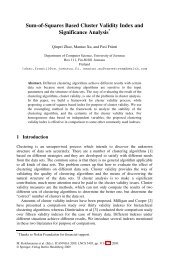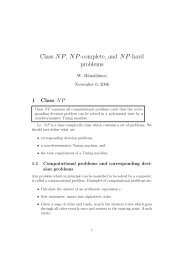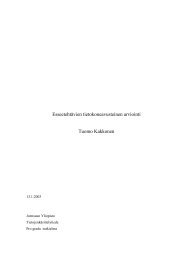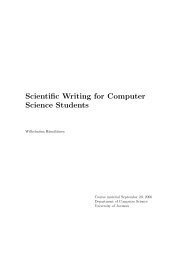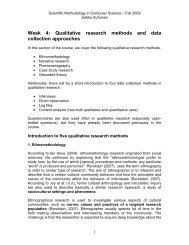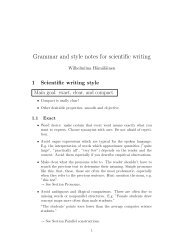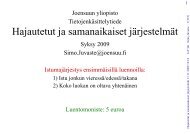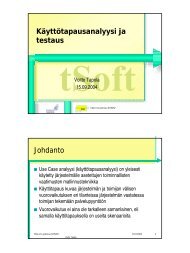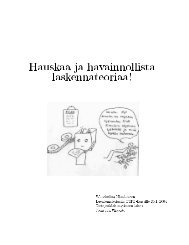Extending external validity measures for determining the ... - Joensuu
Extending external validity measures for determining the ... - Joensuu
Extending external validity measures for determining the ... - Joensuu
Create successful ePaper yourself
Turn your PDF publications into a flip-book with our unique Google optimized e-Paper software.
<strong>Extending</strong> <strong>external</strong> <strong>validity</strong> <strong>measures</strong> <strong>for</strong> <strong>determining</strong> <strong>the</strong> number of clusters<br />
Qinpei Zhao<br />
School of Computing<br />
University of Eastern Finland<br />
<strong>Joensuu</strong>, Finland<br />
qinpei.zhao@uef.fi<br />
Mantao Xu<br />
School of Electronics & In<strong>for</strong>mation<br />
Shanghai Dian Ji University<br />
Shanghai, China<br />
mantao.xu@gmail.com<br />
Pasi Fränti<br />
School of Computing<br />
University of Eastern Finland<br />
<strong>Joensuu</strong>, Finland<br />
pasi.franti@uef.fi<br />
Abstract—External <strong>validity</strong> <strong>measures</strong> in cluster analysis evaluate<br />
how well <strong>the</strong> clustering results match to a prior knowledge<br />
about <strong>the</strong> data. However, it is always intractable to get <strong>the</strong><br />
prior knowledge in <strong>the</strong> practical problem of unsupervised<br />
learning, such as cluster analysis. In this paper, we extend <strong>the</strong><br />
<strong>external</strong> <strong>validity</strong> <strong>measures</strong> <strong>for</strong> both hard and soft partitions by<br />
a resampling method, where no prior in<strong>for</strong>mation is needed.<br />
To lighten <strong>the</strong> time burden caused by <strong>the</strong> resampling method,<br />
we incorporate two approaches into <strong>the</strong> proposed method: (i)<br />
extending <strong>external</strong> <strong>validity</strong> <strong>measures</strong> <strong>for</strong> soft partitions in a<br />
computational time of O(M 2 N); (ii) an efficient sub-sampling<br />
method with time complexity of O(N). The proposed method<br />
is <strong>the</strong>n applied and reviewed in <strong>determining</strong> <strong>the</strong> number of<br />
clusters <strong>for</strong> <strong>the</strong> problem of unsupervised learning, cluster<br />
analysis. Experimental results has demonstrated <strong>the</strong> proposed<br />
method is very effective in solving <strong>the</strong> number of clusters.<br />
Keywords-<strong>external</strong> cluster <strong>validity</strong>, clustering, subsampling,<br />
image segmentation<br />
I. INTRODUCTION<br />
External <strong>validity</strong> <strong>measures</strong> are preferable <strong>for</strong> evaluating<br />
<strong>the</strong> goodness of clusterings when ground truth labels are<br />
available [1]. With <strong>the</strong> ground truth consisting of class labels<br />
assigned to <strong>the</strong> patterns, <strong>the</strong> ideal clustering is selected based<br />
on how well <strong>the</strong> cluster labels produced by <strong>the</strong> algorithm<br />
match. External <strong>measures</strong> are also used to compare <strong>the</strong><br />
similarity of two clustering results.<br />
Rand Index [2], [3], Jaccard coefficient, Fowlkes and<br />
Mallows index [4] are typical <strong>external</strong> <strong>measures</strong>, which<br />
evaluate <strong>the</strong> clustering quality by <strong>the</strong> similarity of <strong>the</strong> pairs<br />
of data objects in different partitions. A study of 16 <strong>external</strong><br />
<strong>measures</strong> <strong>for</strong> K-means clustering has been conducted in [5].<br />
According to <strong>the</strong> result of this survey, we only investigated<br />
Adjusted Rand Index in <strong>the</strong> experiments.<br />
External <strong>measures</strong> are mainly designed <strong>for</strong> hard partitions.<br />
Researchers shed light on extensions of <strong>external</strong><br />
<strong>measures</strong> <strong>for</strong> fuzzy results. A fuzzy extension of <strong>the</strong> Rand<br />
index has been introduced [6]. O<strong>the</strong>r <strong>measures</strong> such as<br />
adjusted Rand Index, <strong>the</strong> Jaccard coefficient, <strong>the</strong> Fowlkes<br />
and Mallows index have also been derived from <strong>the</strong> same<br />
<strong>for</strong>mulation. However, <strong>the</strong>y are as computationally expensive<br />
as O(M 2 N 2 ), where M is <strong>the</strong> number of clusters and N<br />
is <strong>the</strong> data size. Thanks Michele’s pioneer solution of fuzzy<br />
clustering, <strong>the</strong> computational cost of <strong>external</strong> <strong>measures</strong> has<br />
significantly reduced to O(M 2 N) time [7].<br />
In clustering, however, prior knowledge of <strong>the</strong> data is<br />
usually not available. To overcome this difficulty, Rand<br />
Index was extended to calculate a pairwise stability [8],<br />
where <strong>the</strong> pairwise stability is calculated as <strong>the</strong> variability<br />
of <strong>the</strong> clustering results by resampling <strong>the</strong> original data or<br />
multiple initializations. For example, bootstrap resampling<br />
has been utilized in evaluating <strong>the</strong> fuzzy partition stability<br />
in [9], and its fuzzy extension has been introduced in [6].<br />
However, <strong>the</strong>se methods lead to a high time complexity in<br />
general.<br />
Since <strong>the</strong> goal of image segmentation shares <strong>the</strong> commonalities<br />
with clustering, several clustering methods have been<br />
applied in image segmentation successfully [10]. A common<br />
way to evaluate <strong>the</strong> segmentation result is supervised<br />
evaluation, in which manually segmented reference images<br />
are used as ground truth. However, <strong>external</strong> in<strong>for</strong>mation is<br />
difficult to acquire and require human assistance. Generating<br />
a reference image is also a subjective, and time consuming<br />
task. Even given <strong>the</strong> reference in<strong>for</strong>mation, it is not guaranteed<br />
that <strong>the</strong> reference is unique. Considering <strong>the</strong> difficulty,<br />
a framework <strong>for</strong> a similarity measure is suggested in [11],<br />
where <strong>the</strong> measure is based on an objective comparison<br />
between <strong>the</strong> results from image segmentation algorithms and<br />
several manual segmentations.<br />
In this paper, we mainly extend <strong>the</strong> <strong>external</strong> <strong>measures</strong><br />
by a resampling method to <strong>the</strong> case of cluster analysis<br />
that no ground truth is available. The proposed method<br />
combined both <strong>the</strong> benefits of resampling method and fast<br />
implementation of <strong>external</strong> <strong>measures</strong> in <strong>determining</strong> <strong>the</strong><br />
number of clusters, which is applicable <strong>for</strong> both hard and soft<br />
partitions in clustering problems. With numerous clustering<br />
algorithms and varies of image types, evaluation of <strong>the</strong><br />
segmentation result is an open question. We employed <strong>the</strong><br />
proposed method on segmentation evaluation to prove <strong>the</strong><br />
<strong>validity</strong> of <strong>the</strong> method.<br />
II. EXTERNAL MEASURES<br />
Clustering aims at partitioning a set of N and ddimensional<br />
data points X = {x 1 ,x 2 , ..., x n } into M<br />
978-1-4577-1675-1 c○2011 IEEE<br />
931
clusters. The partition is defined as:<br />
P =[p ij ] N×M ;<br />
M∑<br />
p ij =1 (1)<br />
j=1<br />
Here P is a N × M partition matrix, p ij represents <strong>the</strong><br />
probability of <strong>the</strong> i th point belonging to <strong>the</strong> j th cluster. In<br />
hard clustering, p ij is ei<strong>the</strong>r 0 or 1, while in soft clustering<br />
p ij ∈ (0, 1). Given two partitions P and G, <strong>external</strong><br />
<strong>validity</strong> <strong>measures</strong> are used to measure <strong>the</strong> similarity of two<br />
clusterings by <strong>the</strong> proportion of pairs of vectors that agree by<br />
belonging ei<strong>the</strong>r to <strong>the</strong> same cluster or to different clusters<br />
in both partitions.<br />
A. Hard partitions<br />
External <strong>validity</strong> <strong>measures</strong> can be computed from <strong>the</strong><br />
contingency matrix in O(M 2 + N) time <strong>for</strong> hard partitions.<br />
A contingency matrix is defined as:<br />
C ij =<br />
N∑<br />
I(P (t) =i ∧ G(t) =j) (2)<br />
t=1<br />
where I is <strong>the</strong> indicator function, t is <strong>the</strong> data point, and<br />
i, j < M are <strong>the</strong> group labels. The quantities a, b, c, d are<br />
defined as follows:<br />
a =<br />
M∑<br />
i=1 j=1<br />
j=1<br />
M∑<br />
Cij 2 − N<br />
M∑ M∑<br />
M∑ M∑<br />
b = ( C ij ) 2 −<br />
i=1<br />
i=1<br />
j=1<br />
i=1 j=1<br />
M∑ M∑<br />
M∑ M∑<br />
c = ( C ij ) 2 −<br />
d =<br />
M∑<br />
M∑<br />
i=1 j=1<br />
(C ij<br />
M<br />
∑<br />
i=1 j=1<br />
l∕=i s∕=j<br />
M∑<br />
C ls )<br />
C 2 ij<br />
C 2 ij<br />
These calculate <strong>the</strong> number of points that belongs to <strong>the</strong><br />
same cluster in P and G (a); belongs to <strong>the</strong> same cluster in<br />
P but to different in G (b ); inverse of b (c); are in different<br />
groups in P and G (d). Terms a and d measure <strong>the</strong> amount<br />
of agreement of P and G, whereas terms b and c measure<br />
<strong>the</strong> amount of disagreement. The Adjusted Rand index is<br />
now derived by:<br />
2 × (a × d − b × c)<br />
ARI =<br />
(c × c + b × b +2× a × d +(a + d) × (c + b))<br />
(4)<br />
The definitions of Rand index, Jaccard coefficient and<br />
Fowlkes-Mallows indices are all based on Eq. 3, see [6],<br />
[7] <strong>for</strong> <strong>the</strong> exact definition.<br />
(3)<br />
B. Efficient extension to soft partitions<br />
An efficient extension of <strong>external</strong> <strong>measures</strong> into soft<br />
partitions in [7] is based on an update definition of contingency<br />
matrix. In soft partitions, each point has a membership/probability<br />
value to each cluster. The calculation of<br />
contingency matrix <strong>for</strong> soft partitions is defined as:<br />
C ij =<br />
N∑<br />
(P ti + G tj ) α (5)<br />
t=1<br />
where, t is <strong>the</strong> data point, i, j are <strong>the</strong> number of cluster.<br />
The value α is used to boost <strong>the</strong> influence of higher memberships<br />
and reduced <strong>the</strong> influence of lower memberships. We<br />
discuss its setting in Section IV. Given two soft partitions<br />
of <strong>the</strong> same data set, <strong>the</strong> contingency matrix is calculated<br />
according to Eq. 5. The calculations of a, b, c, d are <strong>the</strong> same<br />
as in Eq. 3 with <strong>the</strong> only difference of <strong>the</strong> calculation of a,<br />
which is defined as follows:<br />
M∑ M∑ M∑ M∑<br />
a = Cij 2 − C ij (6)<br />
i=1 j=1<br />
i=1 j=1<br />
The time complexity of <strong>the</strong> soft version is O(M 2 N).<br />
III. DETERMINING THE NUMBER OF CLUSTERS<br />
For <strong>determining</strong> <strong>the</strong> number of clusters, <strong>the</strong> basic idea is to<br />
test whe<strong>the</strong>r <strong>the</strong> points in a data set are randomly structured<br />
or not. Resampling techniques such as bootstrapping [12],<br />
subsampling [13], cross validation [14], sampling by Monte<br />
Carlo method [15] have been utilized as a solution <strong>for</strong> this<br />
problem. They allow one to simulate <strong>the</strong> process of estimating<br />
<strong>the</strong> probability density function of a <strong>validity</strong> <strong>measures</strong><br />
using random numbers, i.e. <strong>the</strong> resampling-based method<br />
discover <strong>the</strong> structure of <strong>the</strong> data by simulation. However,<br />
as a non-parametric method <strong>the</strong> resampling method requires<br />
high computation.<br />
We propose a resampling-based method <strong>for</strong> <strong>determining</strong><br />
<strong>the</strong> number of clusters in a more efficient way. The idea of<br />
this method is to estimate index(k) by comparing an index<br />
value on <strong>the</strong> original data I x with an expectation under index<br />
values on an appropriate null reference distribution of <strong>the</strong><br />
data I u . The estimated optimal number of clusters is <strong>the</strong><br />
value that minimizes index(k).<br />
index(k) =E b [I u ] − I x (7)<br />
where E b denotes expectation under a sample with size B<br />
from <strong>the</strong> reference uni<strong>for</strong>m distribution. This idea is similar<br />
with <strong>the</strong> gap-statistic [15]. The most significant difference<br />
is that <strong>the</strong> proposed method is applied to <strong>external</strong> <strong>measures</strong>,<br />
which are working differently with internal <strong>measures</strong>. The<br />
proposed method is applicable both to hard and soft clusterings.<br />
To speed up <strong>the</strong> method, an efficient extension of soft<br />
<strong>external</strong> <strong>measures</strong> and a sub-sampling method are employed.<br />
The proposed method is described in Algorithm 1. First,<br />
we per<strong>for</strong>m a sub-sampling algorithm [16] with O(N) time<br />
complexity on <strong>the</strong> original data set to reduce <strong>the</strong> computation.<br />
The parameters setting is <strong>the</strong> same as in [16]. Clustering<br />
932 2011 11th International Conference on Intelligent Systems Design and Applications
index value<br />
0<br />
−0.2<br />
−0.4<br />
time (10 3 s)<br />
3<br />
2<br />
1<br />
−0.6<br />
0 10 20 30<br />
number of clusters<br />
0<br />
20 40 60 80 100 200 500 1000<br />
parameter B<br />
Figure 1. The settings of parameter B make little difference on <strong>the</strong> per<strong>for</strong>mance of <strong>the</strong> proposed index (left) while <strong>the</strong> processing time increases with <strong>the</strong><br />
increment of B value (right).<br />
algorithm is run on <strong>the</strong> sub-sampled data X s , and P x is <strong>the</strong><br />
result. We compute an index value I x of <strong>the</strong> defined <strong>external</strong><br />
index between a reference partition G and P x . Here, G is<br />
built according to <strong>the</strong> intuition about <strong>the</strong> clustering structure<br />
of <strong>the</strong> data set that <strong>the</strong> data set is not randomly collected.<br />
Let c = ⌊N/M⌋, <strong>the</strong> reference partition G N×M is generated<br />
by:<br />
{<br />
1,if i>(j − 1) × c & i
partitions in different α settings in Table II. As shown in<br />
<strong>the</strong> table, it has very high correlation among <strong>the</strong> ARI values<br />
on α =10, α =15and α =20. However, it has very low<br />
correlation among <strong>the</strong> values when α =1and <strong>the</strong> o<strong>the</strong>rs.<br />
The correlation of <strong>the</strong> ARI values on hard partitions and soft<br />
partitions is <strong>the</strong> highest when α =5. Thus, we set α =5in<br />
this paper.<br />
Table II<br />
SPEARMAN’S RANK CORRELATION AMONG ARI FOR HARD PARTITIONS<br />
AND ARI FOR SOFT PARTITIONS IN DIFFERENT α SETTINGS.<br />
hard α=1 α=5 α=10 α=15 α=20<br />
hard 1 0.65 0.87 0.79 0.78 0.76<br />
α=1 0.65 1 0.64 0.57 0.53 0.51<br />
α=5 0.87 0.64 1 0.95 0.93 0.91<br />
α=10 0.79 0.57 0.95 1 0.99 0.98<br />
α=15 0.78 0.53 0.93 0.99 1 1<br />
α=20 0.76 0.51 0.91 0.98 1 1<br />
original data<br />
subsampled data<br />
0<br />
−0.1<br />
−0.2<br />
−0.3<br />
−0.4<br />
−0.5<br />
−0.6<br />
subsampled data<br />
original data<br />
0 5 10 15 20 25 30<br />
number of clusters<br />
Figure 2. Original and sub-sampled data distribution (left) and <strong>the</strong> results<br />
from <strong>the</strong> proposed method on both data sets (right).<br />
A. Sub-sampling algorithm<br />
First, we need to verify if <strong>the</strong> sub-sampling algorithm<br />
affects <strong>the</strong> final result. As shown in Fig. 2, <strong>the</strong> original<br />
data size is sampled from 5000 to 1724 data points so that<br />
<strong>the</strong> data structure is preserved while <strong>the</strong> density is reduced.<br />
The result of <strong>the</strong> proposed method on <strong>the</strong> sub-sampled data<br />
has similar trend as that on <strong>the</strong> original data in Fig. 2.<br />
It indicates that <strong>the</strong> sub-sampled data works well in our<br />
method, although variation exists.<br />
Table III<br />
THE PROCESSING TIME WITHOUT AND WITH SUB-SAMPLING ON<br />
DIFFERENT PARTS IN THE PROPOSED METHOD. THE RUNNING TIME FOR<br />
THE SUB-SAMPLING PROCEDURE IS 0.09 SECONDS.<br />
without with reduced<br />
External <strong>measures</strong> 0.13s 0.08s 38%<br />
K-means 8.41s 1.82s 78%<br />
EM 28.43s 8.42s 70%<br />
FCM 42.12s 14.22s 66%<br />
The time costs in Table III are <strong>for</strong> <strong>external</strong> <strong>measures</strong><br />
and clustering algorithms in Algorithm 1 <strong>for</strong> data set S2<br />
with 15 clusters. The sub-sampling method reduces time<br />
cost 38%-78% on different parts in <strong>the</strong> proposed method<br />
according to Table III. Compared to <strong>the</strong> running time <strong>for</strong><br />
sub-sampling procedure, which is 0.09s, <strong>the</strong> reduced time is<br />
much more than that. The sub-sampling method can reduce<br />
remarkable running time in resampling method since <strong>the</strong><br />
clustering algorithms employed in <strong>the</strong> method need to be<br />
repeated multiple times.<br />
B. Determining <strong>the</strong> number of clusters<br />
We tested <strong>the</strong> proposed method on <strong>the</strong> data sets in Table I.<br />
The hard partitions are resulted from K-means and <strong>the</strong> soft<br />
partitions of FCM and EM algorithm by taking <strong>the</strong> cluster<br />
with <strong>the</strong> maximal membership value.<br />
An example on data S2 is shown in Fig. 3, where <strong>the</strong> data<br />
distribution with partitioning from FCM is displayed. The<br />
running time of <strong>the</strong> proposed method varies from different<br />
clustering algorithms, where K-means is <strong>the</strong> fastest and EM<br />
is <strong>the</strong> slowest. Thus, <strong>the</strong> running time depends highly on<br />
<strong>the</strong> choice of <strong>the</strong> clustering algorithm. Compare hard and<br />
soft clusterings, <strong>for</strong> example, hard and soft partitions from<br />
FCM and EM, <strong>the</strong> computation time have little difference<br />
as Fig. 3 indicates.<br />
The index values of <strong>the</strong> proposed method with <strong>the</strong> increasing<br />
number of clusters are plotted, where <strong>the</strong> minimal<br />
values of <strong>the</strong> curve indicate <strong>the</strong> number of clusters. For data<br />
set S2, <strong>the</strong> proposed method reveals <strong>the</strong> structure of <strong>the</strong> data<br />
set on hard partitions from different clustering algorithms.<br />
Results from soft partitions work similar as those from hard<br />
partitions with higher variance. The main reason is that<br />
<strong>external</strong> <strong>measures</strong> on hard partitions are more robust than<br />
that of soft partitions.<br />
To validate <strong>the</strong> proposed method, we listed <strong>the</strong> determined<br />
number of clusters <strong>for</strong> <strong>the</strong> data presented in Table I by<br />
<strong>the</strong> proposed method and two internal <strong>measures</strong> [20] in<br />
Table IV. Calinski-Harabsz (CH) index is popular as an<br />
internal measure, which is based on within and between<br />
cluster variance. Xie and Beni proposed a <strong>validity</strong> index<br />
(XB) <strong>for</strong> fuzzy clustering, which considered <strong>the</strong> data set,<br />
geometric distance measure, distance between cluster centroids<br />
and more importantly on <strong>the</strong> fuzzy partition generated<br />
by any fuzzy algorithm used. We employed K-means results<br />
<strong>for</strong> Calinski-Harabsz index and FCM results <strong>for</strong> Xie-Beni<br />
index. The bold-faced numbers in Table IV represents <strong>the</strong><br />
correctly determined number of clusters.<br />
For <strong>determining</strong> <strong>the</strong> number of clusters, <strong>the</strong> proposed<br />
method works well on real data sets and small Gaussiandistributed<br />
data sets. For higher overlapped data S3 and<br />
S4, <strong>the</strong> proposed method works well. In general, it has<br />
better per<strong>for</strong>mance on hard partitions than soft ones. Internal<br />
<strong>measures</strong> have less accurate result on real data sets, but Xie-<br />
Beni index works well on artificial data sets.<br />
934 2011 11th International Conference on Intelligent Systems Design and Applications
4500<br />
4000<br />
4011<br />
3500<br />
3355<br />
Time (seconds)<br />
3000<br />
2500<br />
2000<br />
1500<br />
1000<br />
991<br />
1263<br />
500<br />
0<br />
195<br />
KM FCM_H EM_H FCM_S EM_S<br />
index value<br />
0<br />
−0.1<br />
−0.2<br />
−0.3<br />
−0.4<br />
−0.5<br />
KM H<br />
FCM H<br />
0.1<br />
−0.1<br />
EM H<br />
0 5 10 15 20 25 30<br />
index value<br />
−0.3<br />
−0.5<br />
FCM S<br />
EM S<br />
−0.6<br />
−0.7<br />
0 5 10 15 20 25 30<br />
number of clusters<br />
number of clusters<br />
Figure 3. (a) a clustering on data set S2 from FCM; (b) a comparison on <strong>the</strong> running time of <strong>the</strong> proposed method on different soft and hard clusterings;<br />
(c) and (d) <strong>the</strong> index value of <strong>the</strong> proposed method (hard and soft clustering respectively) on <strong>the</strong> increasing number of clusters.<br />
Table IV<br />
THE NUMBER OF CLUSTERS DETERMINED BY THE PROPOSED METHOD FOR HARD AND SOFT PARTITIONS.<br />
Data KM H FCM H EM H FCM S EM S XB CH<br />
Iris 3 3 3 3 2 2 2<br />
wine 3 3 3 3 3 2 2<br />
wdbc 2 2 2 6 8 2 2<br />
Zernike 10 5 10 4 10 2 2<br />
image 3 3 3 5 5 2 2<br />
rdata3 3 3 3 3 2 3 10<br />
Touching 2 2 2 3 6 2 2<br />
S1 17 14 17 13 18 15 15<br />
S2 15 14 14 14 15 15 20<br />
S3 15 15 15 15 15 4 6<br />
S4 15 15 15 15 15 15 16<br />
C. Unsupervised evaluation of image segmentation<br />
For image segmentation, K-means, FCM and EM algorithms<br />
are conducted. For simplification, <strong>the</strong> segmentation<br />
results are represented by <strong>the</strong> clustering labels. We use <strong>the</strong><br />
proposed method to determine <strong>the</strong> number of clusters <strong>for</strong><br />
images. The proposed index and BIC (Bayesian In<strong>for</strong>mation<br />
Criterion) are used to evaluate <strong>the</strong> segmentation results, see<br />
Fig. 4, where <strong>the</strong> image in YUV color space is segmented<br />
into 3 clusters by different algorithms. The evaluation under<br />
different numbers of clusters (from 2 to 10) are shown in<br />
Fig. 5. There is a strong indication on three clusters by <strong>the</strong><br />
proposed method, whereas BIC on EM algorithm has no<br />
clear suggestion.<br />
Figure 4. An image in YUV color space and image segmentations of three<br />
clusters by KM, EM and FCM.<br />
2011 11th International Conference on Intelligent Systems Design and Applications 935
0<br />
KM H<br />
FCM H<br />
−3.0<br />
−3.2<br />
−0.05<br />
local minimum<br />
EM H<br />
−3.4<br />
index value<br />
−0.1<br />
−0.15<br />
BIC (10 6 )<br />
−3.6<br />
−3.8<br />
−4.0<br />
−4.2<br />
local maximas<br />
−0.2<br />
1 3 5 7 9<br />
number of clusters<br />
−4.4<br />
1 3 5 7 9<br />
number of clusters<br />
Figure 5.<br />
Evaluation results of <strong>the</strong> proposed method (left) and BIC (right) <strong>for</strong> <strong>the</strong> image.<br />
V. CONCLUSION<br />
We extended <strong>the</strong> <strong>external</strong> <strong>measures</strong> <strong>for</strong> both hard and soft<br />
partitions in clustering problems when no prior in<strong>for</strong>mation<br />
is available. To <strong>the</strong> computational efficiency of resampling<br />
method, a state-of-art sub-sampling method is implemented<br />
and applied instead. Experimental results indicate that <strong>the</strong><br />
proposed method are very effective in solving <strong>the</strong> number<br />
of clusters in practice, <strong>for</strong> example, <strong>the</strong> unsupervised evaluation<br />
of image segmentation. The proposed method can be<br />
envisioned as a general approach that can be applicable to<br />
o<strong>the</strong>r clustering algorithms and <strong>external</strong> <strong>measures</strong>.<br />
REFERENCES<br />
[1] B. E. Dom, “An in<strong>for</strong>mation-<strong>the</strong>oretic <strong>external</strong> cluster-<strong>validity</strong><br />
measure,” Research Report RJ 10219, IBM, 2001.<br />
[2] W.M. Rand, “Objective criteria <strong>for</strong> <strong>the</strong> evaluation of clustering<br />
methods,” Journal of <strong>the</strong> American Statistical Association,<br />
vol. 66, pp. 846–850, 1971.<br />
[3] N. X. Vinh, J. Epps, and J. Bailey, “In<strong>for</strong>mation <strong>the</strong>oretic<br />
<strong>measures</strong> <strong>for</strong> clustering comparison: Is a correction <strong>for</strong> chance<br />
necessary?,” ICML’09, pp. 1073–1080, 2009.<br />
[4] E.B. Fowlkes and C.L. Mallows, “A method <strong>for</strong> comparing<br />
two clusterings,” Journal of <strong>the</strong> American Statistical Association,<br />
vol. 75, pp. 553–569, 1983.<br />
[5] J. Wu, H. Xiong, and J. Chen, “Adapting <strong>the</strong> right <strong>measures</strong><br />
<strong>for</strong> k-means clustering,” KDD’09, pp. 877–886, 2009.<br />
[6] R.J.G.B. Campello, “A fuzzy extension of <strong>the</strong> rand index<br />
and o<strong>the</strong>r related indexes <strong>for</strong> clustering and classification<br />
assessment,” Pattern Recognition Letters, vol. 28, no. 7, pp.<br />
833–841, 2007.<br />
[7] C. Michele and M. Antonio, “A fuzzy extension of some<br />
classical concordance <strong>measures</strong> and an efficient algorithm<br />
<strong>for</strong> <strong>the</strong>ir computation,” Int’l Conf. on Knowledge-Based<br />
Intelligent In<strong>for</strong>mation and Engineering Systems, pp. 755–<br />
763, 2008.<br />
[8] L.I. Kuncheva and D.P. Vetrov, “Evaluation of stability of<br />
k-means cluster ensembles with respect to random initialization,”<br />
IEEE TPAMI, vol. 28, no. 11, pp. 1798–1808, 2006.<br />
[9] M. Falasconi, A. Gutierrez, M. Pardo, G. Sberveglieri, and<br />
S. Marco, “A stability based <strong>validity</strong> method <strong>for</strong> fuzzy<br />
clustering,” Pattern Recognition, vol. 43, no. 4, pp. 1292–<br />
1305, 2010.<br />
[10] C. Carson, S. Belongie, H. Greenspan, and J.Malik, “Blobworld:<br />
Image segmentation using expectation-maximization<br />
and its application to image querying,” IEEE TPAMI, vol.<br />
24, no. 8, pp. 1026–1038, 2002.<br />
[11] R. Unnikrishnan, C. Pantofaru, and M. Hebert, “Toward<br />
objective evaluation of image segmentation algorithms,” IEEE<br />
TPAMI, vol. 29, pp. 929–944, 2007.<br />
[12] M.H.C. Law and A.K. Jain, “Cluster <strong>validity</strong> by bootstrapping<br />
partitions,” Technical Report MSU-CSE-03-5, Dept. of<br />
Computer Science and Engineering, MSU, Michigan, USA,<br />
2003.<br />
[13] E. Levine and E. Domany, “Resampling method <strong>for</strong> unsupervised<br />
estimation of cluster <strong>validity</strong>,” Neural Computation,<br />
vol. 13, pp. 129–137, 2001.<br />
[14] W.M. Abd-Elhafiez A. Farag M. El-Melegy, E.A. Zanaty,<br />
“on cluster <strong>validity</strong> indexes in fuzzy and hard clustering<br />
algorithms <strong>for</strong> image segmentation,” ICIP’07, pp. 5–8, 2007.<br />
[15] R. Tibshirani, G. Wal<strong>the</strong>r, and T. Hastie, “Estimating <strong>the</strong><br />
number of clusters in a data set via <strong>the</strong> gap statistic,” Journal<br />
of <strong>the</strong> Royal Statistical Society, vol. 63, pp. 411–423, 2001.<br />
[16] T. Hasan, Y. Lei, A. Chandrasekaran, and J.H.L. Hansen,<br />
“A novel feature sub-sampling method <strong>for</strong> efficient universal<br />
background model training in speaker verification,”<br />
ICASSP’10, pp. 4494–4497, 2010.<br />
[17]K.V.Mardia,J.T.Kent,andJ.M.Bibby,<br />
analysis,” Academic Press, 1979.<br />
“Multivariate<br />
[18] A. Asuncion and D.J. Newman, “UCI machine learning<br />
repository,” http://archive.ics.uci.edu/ml/, 2007.<br />
[19] Jerome L. Myers and Arnold D. Well, “Research design and<br />
statistical analysis (second edition ed.),” Lawrence Erlbaum,<br />
p. 508, 2003.<br />
[20] Q. Zhao, M. Xu, and P. Fränti, “Sum-of-square based cluster<br />
<strong>validity</strong> index and significance analysis,” ICANNGA, pp. 313–<br />
322, 2009.<br />
936 2011 11th InternationalConference on Intelligent Systems Design and Applications



